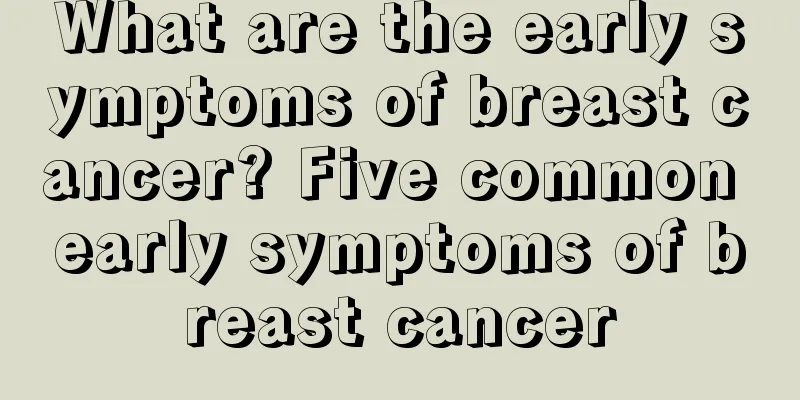What are the early symptoms of breast cancer? Five common early symptoms of breast cancer

|
Breast cancer is a cancer that threatens women's lives. Do you know the early symptoms of breast cancer? How to check? Breast cancer is a malignant tumor that poses a great threat to women's health. The harm is self-evident. In recent years, the incidence of breast cancer has continued to rise, seriously affecting the physical and mental health of many women. Therefore, it is important to understand the early symptoms of breast cancer in a timely manner. Many patients have missed the best treatment opportunity because the early symptoms are not obvious and are not discovered until the late stage, making treatment very difficult. Early symptoms of breast cancer Lump or pain This is the first symptom of 95% of breast cancer patients. It is mostly single, rare and multiple, and the shape is round, oval or irregular. The texture is generally hard and the boundaries are unclear. When breast cancer is combined with cystic hyperplasia, swelling and dull pain may occur. Pain in advanced breast cancer often indicates that the tumor directly invades the nerves. 2. Changes in nipple and areola Breast cancer is in the center of the breast and the large ducts are invaded, which can cause the nipple to flatten, become sunken, shrink, or even fall down, resulting in deformation of the areola. 3. Skin changes Common manifestations include superficial venous distention, dimples, and orange peel skin. Axillary lymphadenopathy The first symptom of breast cancer is rare (unless it is occult breast cancer). Most of them indicate the progression of breast cancer, and pathological examination can help to diagnose. 5. Nipple discharge Breast cancer with discharge accounts for 1.3-7% of all breast cancers, and is more common in intraductal carcinoma and papillary carcinoma. Bloody discharge is the most common, followed by serous, serous blood, and watery discharge. Clinical Detection Methods for Breast Cancer Breast palpation examination Every woman should do a self-examination on the fifth day after the end of menstruation. The method is to apply soap on your hands and use the belly of the middle finger and index finger to search the breasts, armpits and clavicle fossa clockwise. Experts are very experienced and it is more accurate to judge whether there is a lump by touch. If you feel a lump when you touch your breast, it may be breast cancer. Take off your jacket, face the mirror, and check if the nipple is protruding, the skin is wrinkled, sunken, the nipple is contracted, the level of the nipples on both sides is consistent, and the contour has changed. Raise your left arm, put your right index finger, middle finger, and ring finger together, and use the belly of your fingers to gently press the left breast area to see if there are lumps. Be careful not to pinch with your fingers. Check the right breast in the above way. Lie on your back, with your left arm over your head, and a small pillow under your left shoulder. Check again according to steps 2 and 3; if you find lumps, nodules, or other abnormalities, you should go to the cancer hospital in time. Skin changes: Breast cancer invading the skin can cause skin-specific changes, with orange skin being the most vivid; there is also a special type of breast cancer that manifests mainly as inflammatory changes in the breast skin, with skin color ranging from light red to dark red, accompanied by skin edema, thickening, and increased surface temperature, which can extend from local areas to the entire breast. 2.Use B-ultrasound examination When a doctor suspects a breast lump, he must do a B-ultrasound to determine the nature and location of the lump. However, B-ultrasound can only identify lumps with a diameter of less than 1 cm and may miss smaller lumps. 3. Check with mammography target This is the most accurate method for the initial diagnosis of breast cancer. It can obtain clear images and detect the budding of some small tumors, but the cost is higher than B-ultrasound examination. |
<<: Does IVF increase the risk of breast cancer? 6 common misunderstandings about IVF
Recommend
What is the reason for heaviness in calves
Many people have experienced the symptom of heavy...
What are the symptoms of phosphorus deficiency in the body?
Phosphorus is a metallic element that is widely p...
What are the symptoms of lung cancer lymph node metastasis? Pay attention to these points
The clinical symptoms of lung cancer lymph node m...
Is interventional treatment for lung cancer painful?
Is interventional treatment for lung cancer painf...
What are the dangers of teeth cleaning
Teeth are very important parts of our body. Once ...
What kind of honey can detoxify and nourish the skin? It turns out to be this kind
Honey is a common nutritional health food in peop...
How to treat knee aging
The knee joint will age with age, which cannot be...
Is lettuce bitter and poisonous
Lettuce is a kind of green vegetable rich in vari...
How much does chemotherapy for advanced colorectal cancer cost
How much does chemotherapy for advanced colorecta...
Treatment for deafness
We all know that some people around us cannot hea...
What are the adverse reactions to leprosy vaccination
Leprosy is a serious disease, so in order to prev...
How long does it take to do a DNA test after pregnancy?
Due to various reasons, some women may have unexp...
The harm of Huangjingzi pillow
Huangjingzi is also called Wuzhiganzi. It is a Ch...
Hard contact lenses
Contact lenses are a common way of correcting vis...
Viral headache
Viral headache refers to a headache caused by a v...









